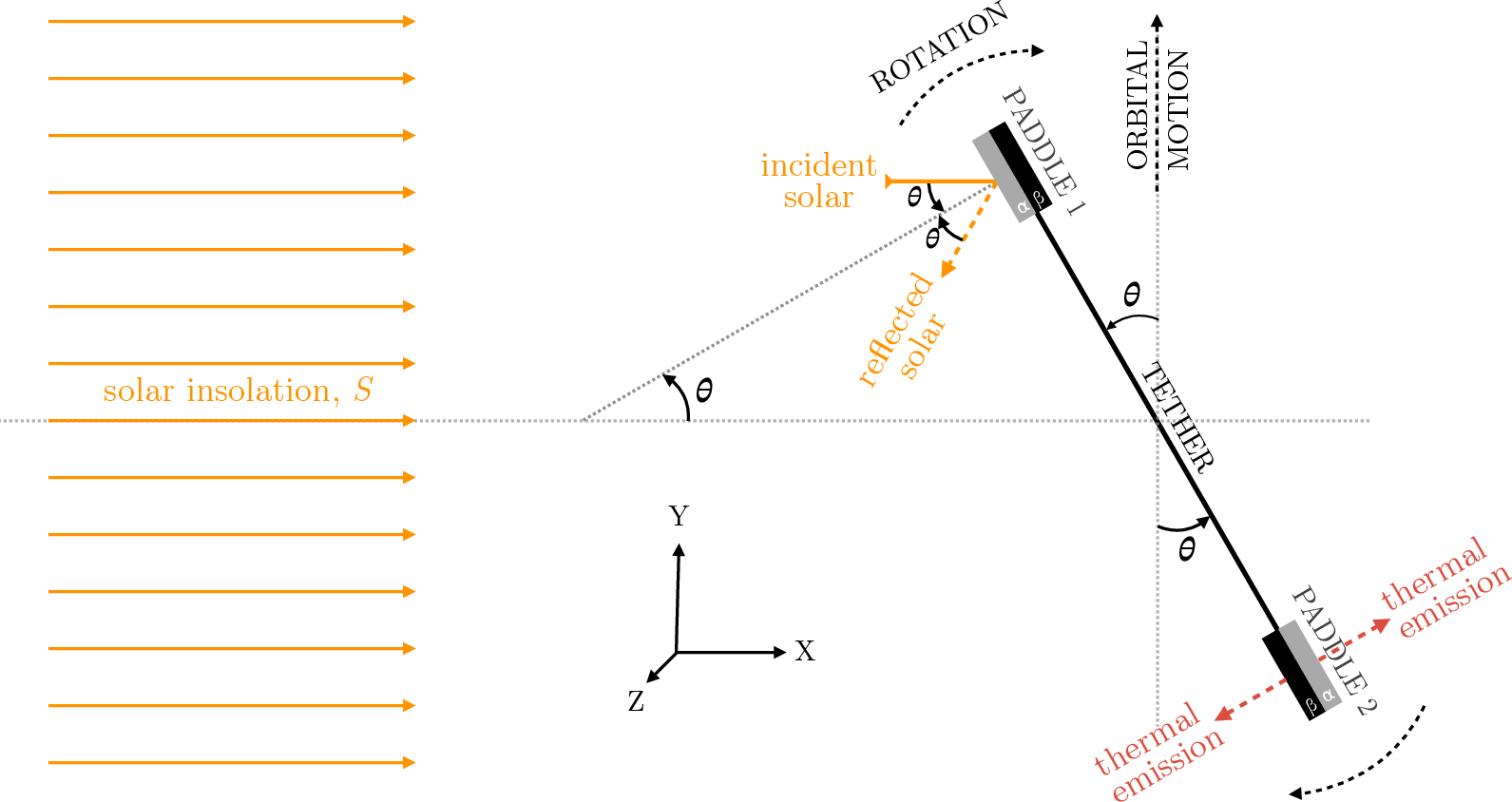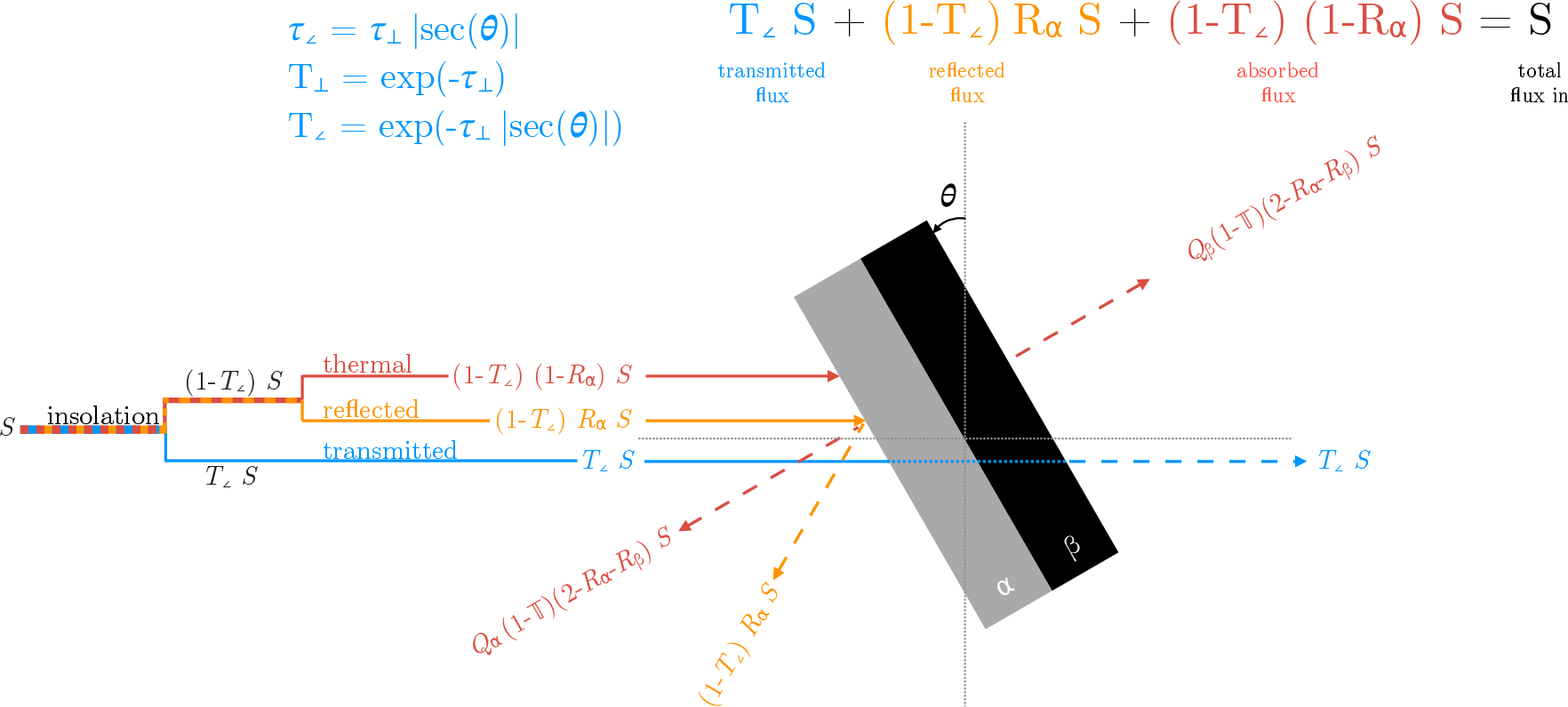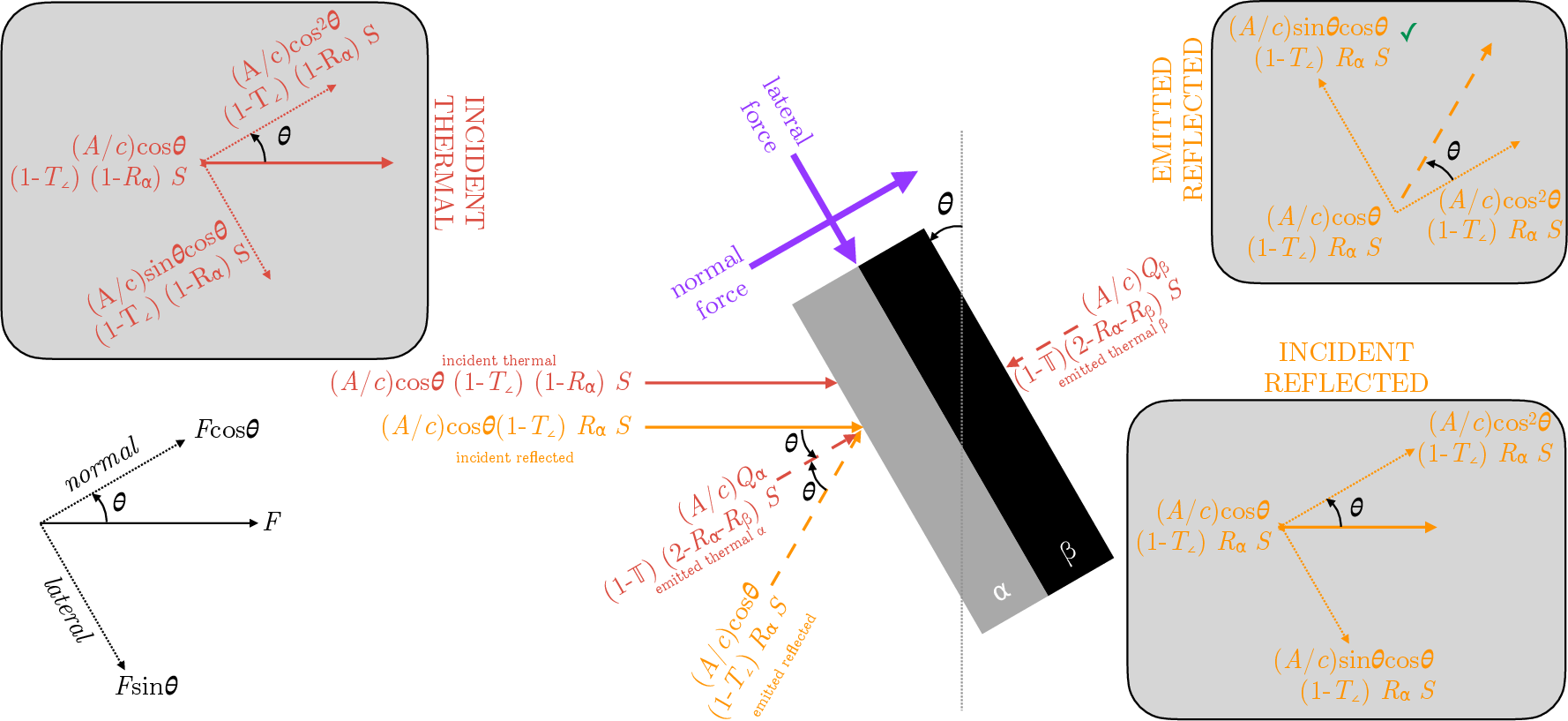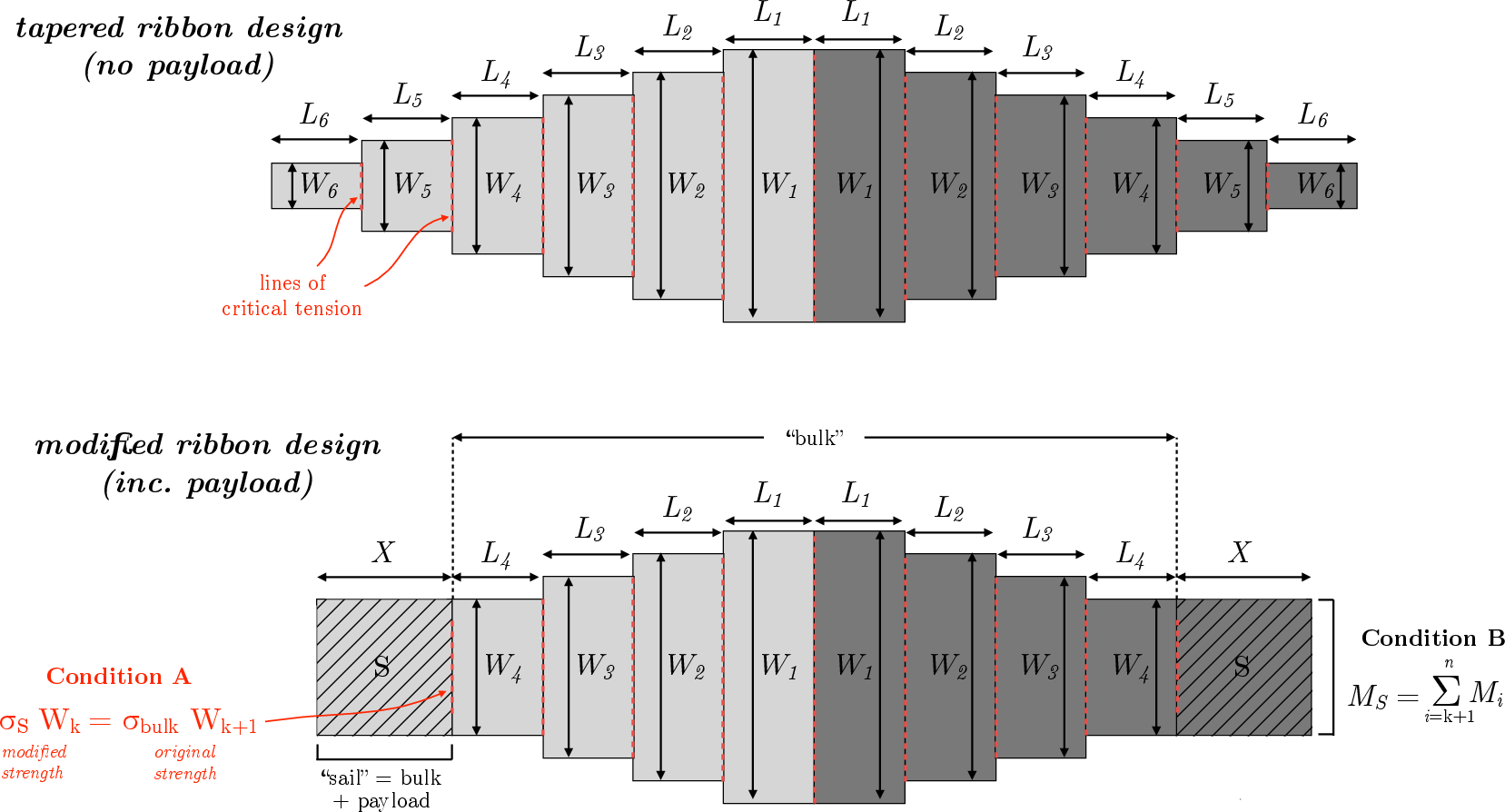Torqued Accelerator using Radiation from the Sun (TARS) for Interstellar Payloads (2507.17615v1)
Abstract: The concept of exploring space using solar power is energetically appealing, but interstellar solar sails typically require extremely low areal densities (~0.8 g/m2). This work explores an alternative approach: storing solar energy as rotational kinetic energy, which is later released to propel a microprobe beyond the solar system. The proposed Torqued Accelerator using Radiation from the Sun (TARS) consists of two thin surfaces with contrasting albedos that gradually spins up over weeks to months while in a sub-Keplerian "quasite" orbit around the Sun. Though constrained by material strengths, careful design allows a phone-sized payload to reach interstellar velocities in less than a year, using commercially available materials (e.g. CNT sheets). The entire system spans tens of meters and weighs of order of a kilogram. Whilst there is no theoretical limit to the achievable speeds, practical designs grow exponentially in size as velocity targets increase, making interstellar flight feasible but relativistic speeds implausible. Several strategies, including the use of graphene sheets, gravity assists, the Oberth effect, and electrostatic confinement, could further maximise velocity. TARS is an attractive light sail technology when high-powered directed energy systems are impractical, offering a potentially low-cost solution for deploying small, sub-relativistic interstellar probes.
Summary
- The paper presents a novel approach where solar radiation generates torque to store rotational energy, decoupling energy accumulation from payload acceleration.
- The TARS design utilizes asymmetric paddle surfaces and optimized tether engineering to achieve solar escape velocities with current materials like CNT sheets.
- Performance analysis demonstrates sub-relativistic interstellar missions are feasible despite exponential mass scaling limiting higher speeds with existing technology.
Torqued Accelerator using Radiation from the Sun (TARS): A Novel Approach to Interstellar Payload Acceleration
Introduction and Motivation
The TARS (Torqued Accelerator using Radiation from the Sun) concept introduces a fundamentally distinct paradigm for solar-driven propulsion of interstellar payloads. Unlike conventional solar sails, which rely on direct linear acceleration from radiation pressure and thus require extremely low areal densities to overcome solar gravity, TARS leverages solar radiation to incrementally store energy as rotational kinetic energy in a flywheel-like structure. This stored energy is subsequently converted into linear kinetic energy by releasing a payload at the system's periphery, enabling escape from the solar system with areal densities and material strengths achievable by current technology.
System Architecture and Physical Principles
TARS consists of two thin, paddle-like surfaces (with contrasting albedos) connected by a tether, forming a rotating structure in a sub-Keplerian "quasite" orbit around the Sun. The system is designed such that incident solar radiation imparts both a net outward force and a torque due to the asymmetric reflectivity and emissivity of the paddle surfaces. The torque gradually spins up the system over weeks to months, storing energy in rotation.

Figure 1: A simplified schematic of the TARS system, showing two paddles connected by a tether in orbit around the Sun. The system's velocity vector is along Y^, and the asymmetric paddle surfaces generate a net torque from solar radiation.
The key innovation is the use of rotational energy storage, which decouples the energy accumulation phase from the payload acceleration phase. This allows TARS to remain close to the Sun, maximizing incident flux, until the moment of payload release.
Radiative Fluxes and Force Analysis
The incident solar flux on each paddle is partitioned into transmitted, reflected, and absorbed components, with subsequent thermal re-emission. The analysis accounts for the phase-averaged absorption and emission, assuming thermal equilibrium over the rotation period. The effective transmission, reflectivity, and emission fractions are parameterized for both paddle surfaces.

Figure 2: Breakdown of incident and emitted fluxes for a TARS paddle, illustrating the roles of transmission (T), reflectivity (R), and heat transport (Qα).
The net force on each paddle is decomposed into normal and lateral components, with the torque arising from the difference in normal forces due to the contrasting surface properties. The design constraint F⊥,α≥F⊥,β ensures a net torque in the desired direction.

Figure 3: Decomposition of forces acting on a paddle with the α-side Sun-incident. Insets detail the force components for incident thermal, emitted reflected, and incident reflected cases.
Spin-Up Dynamics and Quasite Orbits
The spin-up of TARS is governed by the net torque and the system's moment of inertia. The angular acceleration is given by ω˙=FRδ/I, where FR is the phase-averaged net torque, δ is the lever arm, and I is the moment of inertia. The system's center-of-mass experiences a net outward force, but by operating in a sub-Keplerian quasite orbit, TARS maintains a stable position relative to the Sun, avoiding the rapid decrease in incident flux that would occur if it simply drifted outward.
The effective gravitational mass of the Sun is reduced by the radiation pressure, modifying the orbital dynamics. The system's areal density is chosen such that it remains gravitationally bound, but with a reduced orbital velocity.
Payload Release and Critical Velocity
Upon reaching the desired rotational velocity, a payload is released tangentially from the system's periphery. The critical velocity is set by the tensile strength of the ribbon or tether, with vcrit=2σ/ρ for a uniform ribbon, where σ is the tensile strength and ρ is the density.
The release can be timed to coincide with a specific orbital phase, optimizing the payload's trajectory. The system can be designed to achieve solar system escape velocity, with the required vtarg depending on the release radius and the effective reduction in solar mass due to the quasite effect.
Structural Design: Uniform and Tapered Ribbons
The simplest TARS implementation is a uniform ribbon, but this is suboptimal since the tension decreases away from the rotation axis. A tapered ribbon design, in which the width decreases toward the ends, allows for more efficient use of material strength, enabling higher critical velocities for a given mass.

Figure 4: Tapered ribbon design for TARS. Top: Homogeneous, payload-free ribbon. Bottom: Modified design with a payload-containing sail segment at the end, with increased width to compensate for reduced specific strength.
The design is further refined by incorporating a payload segment at the ribbon's end, with the width increased to maintain structural integrity despite the lower specific strength of the payload composite. The system parameters (number of segments n, payload segment index k, widths Wi, and lengths) are optimized to balance mass, stability, and achievable velocity.
Performance Analysis and Scaling
Numerical examples demonstrate that, with commercially available CNT sheets (density $1.6$ g/m3, tensile strength $20$ GPa) and micron-scale thickness, a TARS system with total mass ∼1.6 kg and length ∼60 m can accelerate a smart-phone-sized payload to interstellar escape velocity in less than a year. The achievable areal densities are an order of magnitude higher than those required for statite solar sails, relaxing material constraints.

Figure 5: Payload velocity at release minus solar system escape velocity (black circles/line, left y-axis) and TARS mass (rust squares/grey line, right y-axis) as functions of the design parameter k for the tapered ribbon. The vertical line marks the stability threshold.
The analysis reveals a strong exponential scaling of system mass and size with increasing target velocity, making relativistic speeds impractical with current materials. However, sub-relativistic interstellar flight is feasible.
Extensions and Future Directions
Several strategies are proposed to further enhance TARS performance:
- Material Advances: Adoption of large-area graphene sheets could significantly increase specific strength, enabling higher velocities.
- Orbital Optimization: Utilizing highly eccentric orbits and exploiting the Oberth effect can reduce the required critical velocity for escape.
- Gravity Assists: Sequential planetary flybys can provide additional velocity increments.
- Electrostatic Confinement: Charging the paddle tips to generate a restoring force could augment the effective tensile strength, potentially increasing vcrit by an order of magnitude.
- Hybrid Propulsion: Combining TARS with directed energy systems (e.g., lasers) for post-release acceleration.
The system is inherently multi-use, as the main structure can be recharged and used to launch multiple payloads in sequence, with recharge times much shorter than the initial spin-up.
Practical and Theoretical Implications
TARS offers a viable, low-cost alternative for launching small interstellar probes when high-powered directed energy systems are impractical. The approach circumvents the need for ultra-low areal density sails and massive ground-based infrastructure, instead leveraging existing materials and solar energy. Theoretically, TARS expands the design space for solar-driven propulsion by introducing rotational energy storage as an intermediary, decoupling energy accumulation from payload acceleration.
The exponential scaling of system mass with velocity target imposes a hard limit on achievable speeds, precluding relativistic flight with current technology. However, the system is well-suited for sub-relativistic missions, such as interstellar precursor probes or rapid interplanetary transfers.
Conclusion
The TARS concept represents a technically grounded and analytically tractable approach to solar-driven interstellar propulsion. By storing solar energy as rotational kinetic energy and releasing it in a controlled manner, TARS enables the acceleration of small payloads to interstellar velocities using commercially available materials and without reliance on directed energy infrastructure. While not suitable for relativistic missions, TARS fills a critical niche in the spectrum of light sail technologies and provides a foundation for future advances in material science, orbital mechanics, and hybrid propulsion architectures.
Follow-up Questions
- How does TARS differ fundamentally from conventional solar sail designs in terms of energy storage and propulsion?
- What are the critical parameters in the design of the asymmetric paddle surfaces to ensure optimal torque generation?
- How can improvements in material strength, such as using graphene, enhance the performance of the TARS system?
- What role do orbital dynamics, like the quasi-Keplerian orbit and Oberth effect, play in optimizing payload acceleration?
- Find recent papers about solar-driven interstellar propulsion.
Related Papers
- Ultrafast transfer of low-mass payloads to Mars and beyond using aerographite solar sails (2023)
- The Breakthrough Starshot System Model (2018)
- Low-cost precursor of an interstellar mission (2020)
- Sailing Towards the Stars Close to the Speed of Light (2020)
- A Roadmap to Interstellar Flight (2016)
- Electric sails are potentially more effective than light sails near most stars (2019)
- Propulsion of Spacecrafts to Relativistic Speeds Using Natural Astrophysical Sources (2020)
- Relativistic Light Sails (2017)
- Graphene Sails with Phased Array Optical Drive - Towards More Practical Interstellar Probes (2015)
- Photonic Lightsails: Fast and Stable Propulsion for Interstellar Travel (2025)
Authors (2)
Tweets
YouTube
HackerNews
- Torqued Accelerator Using Radiation from the Sun (Tars) for Interstellar Payload (76 points, 17 comments)
alphaXiv
- Torqued Accelerator using Radiation from the Sun (TARS) for Interstellar Payloads (10 likes, 0 questions)